If you’ve spent any time around musky anglers, you’ve likely heard days measured in “follows”, “eats”, and, sometimes, actual fish in the boat. The elusive musky’s tendency to follow flies to the boat without striking is part of what makes them so frustratingly elusive and captivating. To combat this habit, Esox anglers regularly employ a boatside technique known as the figure-eight to convert those following fish into hooked and, hopefully, bagged fish. Knowing how to effectively employ a figure-eight will increase your success as a musky angler, and enrich your overall experience. Absolutely nothing else in the freshwater realm has left me babbling and weak-kneed like guiding a four-foot-long riverine grizzly around the boat with the tip of a flimsy graphite rod, regardless of whether the fish ends up in the net or not.
Following are some tips to get you on track to converting following fish like a pro.
Understanding the Figure-Eight
First and foremost, the figure-eight is a method of extending, and altering the characteristics of, the retrieve, aimed at triggering a following fish into eating. It is not necessarily defined by a physical figure-eight motion with the rod and fly.
Science has proven that, more often than not, musky attack their prey from the side, as it is the most efficient method for a fish of their build to ensure capture of prey. It’s the reason that many of the most effective musky flies incorporate a jackknifing action, and why musky will follow for so long without striking. If you’re nearing the end of your straight retrieve and it hasn’t succeeded in triggering a musky, the figure-eight is your last-ditch effort to do so.
Thus, a figure-eight maneuver can take the form of a figure-eight; an oval; short, choppy zig-zags; etc.—anything that incorporates the triggers necessary to make a following musky eat.
Maintain Fly and Line Control
An effective figure-eight starts with having the correct amount of leader outside of your rod tip. For me, that starts with leader construction.
The leader setup that I use 90% of the time is a simple marriage of three feet of 30-pound fluorocarbon and 18 inches of 30-pound knotable wire. The two knots in this system allows me to know exactly how much leader I have outside of my rod tip, even when it’s several feet below the surface of the water under low visibility conditions. You’ll hear two clicks as the knots pass through the guides. Stopping shortly after the second click ensures that you have the desired 12 to 18 inches of leader outside of the tip. Any more than this, and you won’t have total control of your fly as you go through turns of the figure-eight. Any less, and you may get your rod tip eaten.
At this point it is also paramount that you maintain control over your fly line. It’s tempting to just clamp down on the line with your rod hand, but always keep the line in your line hand as well, to ensure a solid connection to the fish should you get an eat.

Utilize Depth, Speed, and Direction Change
When fishing deep water, as you near the end of your straight retrieve, push your rod tip deeper in the water to keep the boat out of the fish’s field of view. In really clear water situations, the deeper the better. Though following musky usually have tunnel vision focused on your fly, keeping the fish as far away from the boat can only work for you.
This move will set you up well for working depth, speed, and direction changes into your figure-eight to trigger a take. As your fly nears the boat, speed up your retrieve slightly and transition smoothly into a wide oval or figure-eight turn. Your first turn should usually be away from the boat. Over the course of a turn, I like to move my fly a foot or two up in the water column, and then plunge it back down in the straightaways. As you enter a turn, speed up your fly and maintain speed through the turn and hang it on the corner. Often times, this change in depth and speed, when combined with the turn, seems to simulate a last-ditch effort by the prey to escape a following predator. If the fish is going to eat, it’ll usually be on the outside corner of the turn, when the fish sees the side profile. If it doesn’t, continue the cat and mouse game.
Make Wide Turns
Musky are long fish, and while a hot following fish will sometimes follow tightly through sharp turns in a figure-eight, they can’t turn on a dime. If you make your turns too tight and fast, you risk turning the fly back over on a fish—a general turn-off. Predators aren’t used to being attacked by their prey. Moreover, it seems the tighter the turns, the more effort it takes to follow on the fish’s part, and lazy following fish sometimes disappear if you make them turn sharply.
So, make your turns wide. Wide enough for even the biggest of fish to easily follow, while still showing the fish that side profile on the turn.
Figure-Eight Like You Mean It—Every Time
Plain and simple, if you don’t figure-eight with intent on every cast (I usually opt for two or three complete cycles before starting my next cast if you don’t see a fish), you are blowing opportunities to put musky in the net, since many often times fish follow from just out of sight—below the fly, under the boat, etc. And in a game where one fish in the boat can make for a great week, that’s not a sacrifice you want to make, particularly considering that, on some waters—like my home waters of western Virginia—close to half of the fish boated during the course of a season may get hooked boatside.
If a fish continues to follow through the eight, but doesn’t commit, don’t give up. Keep it up until you trigger an eat or the fish disappears.
Do a Final Check
One October morning I had a client fishing a piece of highly productive musky water. We’d had one fish come up and eat the fly away from the boat and escape unhooked, which I think made the client more serious about his figure-eight. Several casts later, he retrieved his fly back to the boat, made three good figure-eights, and then ripped his fly from the water and started his next cast. He had his eye on his next target, and I was watching the water where his fly had been about 15 seconds before when a respectable musky rose up from the depths, stopped a few inches beneath the surface, and just looked up at where the fly had gone.
Moral of the story? After every figure-eight, pause the fly and let it hang about a foot beneath the surface for a few seconds and scan the water around it for movement. If you see “something,” resume your figure-eight presentation. If not, make your next cast.
Set Into the Fish
When a fish eats your fly on the figure-eight, it’s tempting to rip the fly straight away from the fish. Do your best to set back in the direction of the fish for the best hookup. If the fish lazily swims through your tracking fly with its mouth open, keep dragging until you feel pressure. Nothing hurts more than pulling a fly right out of a fish’s mouth before the hook has made purchase.
Since musky are predatory fish with unique personalities and moods, figure-eight success hinges strongly on the angler’s ability to keep an open mind and read a fish’s body language in the heat of the moment to determine the best way to feed it a fly. However, knowledge of these techniques and triggering mechanisms should get you started and help you turn musky frustration into success.






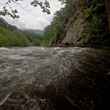
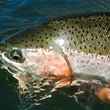



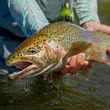




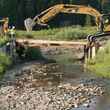










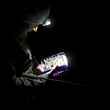

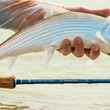
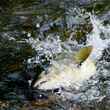
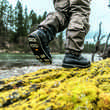
Comments